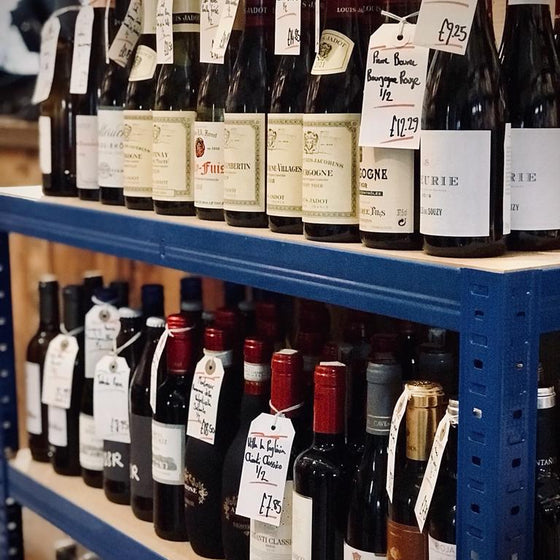I was asked recently to help one our customers slowly build up a little wine collection. His idea was that instead of forking out thousands of pounds to fill a cellar in one go, that each week he would order something special to add to his cellar.
This is actually something I have been doing for myself for while now, every time I order a case of wine to enjoy at home I add in one or two bottles of something I can hide away and wait to age. It’s all too easy to buy wine on the hoof to drink that evening, but there really is something special about opening a bottle you have saved for many years. So if you’re thinking about starting a small wine collection, here are a few some tips on what you need and where you can store it.
If you have a cellar, great, but you don’t need one. The most important element is storing wine is a constant cool temperature. Heat and light are also factors that can affect a wines condition. As a general rule the ideal temperature is between 10 and 15 degrees. Strong light can adversely affect the taste of wine and humidity is important. If a cork dries out it can shrink and let in oxygen. An absence of strong smells is also vital, storing it in the garage, which may seem like an obvious alternative to a cellar, is not a great idea if your garage is full of old paint and chemicals, also the temperature of outside buildings in this country tends to fluctuate too much. So ideally a dark, cool, slightly damp room. As most of may not have access to a cellar here are some useful options:
The Attic (not great if you want to access it often)
Spare Room (under an insulation blanket so not affected by fluctuating temperature and you could keep a bowl of water nearby to keep the humidity up)
Under the stairs (again a bowl of water nearby and perhaps under an insulation blanket)
Once you have found the right location, the wine should be stored lying on its side, again this is to stop the corks drying out. There is a new school of thought that the wines should be kept on an angle; this is to keep the wine and the air bubble in contact with cork. So if you have a wine rack you can always use a wedge to put the bottle at an angle.
Recommendations to start your cellar:
I’ll start with a selection of Bordeaux, as Bordeaux is pretty much a classic for ageing, however there are plenty of wines from al over the world which benefit from ageing, so over the next few weeks I’ll be adding to this list.
Bordeaux
Chateau Beaumont, Haut Medoc (2009) Cru Bourgeois £16.86
The wines of Château Beaumont are characterized by their feminine structure, which is often silky and elegant. The tannins are generally mellow and fine. They can be enjoyed young, but exceptional vintages like 2009 certain vintages absolutely must be allowed to rest for a few years in the cellar. The wines are dominated by Cabernet Sauvignon on this land which is reputed to be among the best for growing this varietal. It is typical of the excellent Garonne gravel ridges which make up the land of the estate and thus the treasure of Beaumont. 2009 was an outstanding vintage so the wine will age well. This wine is a cru Bourgeois so a Medoc wine not included in the 1855 classification, so I think we are looking at 8 – 10 years in the cellar. This is excellent value and a great start for a wine collection.
Chateau Cissac, Haut Medoc (2009) Cru Bourgeois £25.96
Chateau Cissac is an historic Haut-Médoc wine property which dates from 1769. A family owned estate which has been in the vaillard family for over 5 generations. Its reputation was largely based on the tireless work of Louis Vialard, who arrived in 1940 and established the wine’s fame through the 1970s and 1980s. He died in 2009 but his daughter Danielle had long taken over the wine-making and is now assisted by her own daughter, Marie. Today the estate covers an are of 65 hectares, all located within the commune of Cissac and ideally located between St Estephe and Paulliac and growing a tradition range of 75% cabernet Sauvignon, 20% Merlot and 5% Petit Verdot and the average age of the vines is 30 years. Decanter recommends this wine to be drunk between 2014 and 2019. The 2009 is a powerful and racy wine with a remarkable balance and finesse.
Chateau Cantemerle, Haut-Medoc (2009), Grand Cru Classé £30.85
Château Cantemerle, Grand Cru Classé in 1855, is one of the leading château from the Haut-Médoc area. The wine produced from its 222 acres vineyard is renowned for its elegance and refinement, and is distinguished all over the world by wine lovers.
This is a personal favourite of mine, again the fantastic 2009 vintage. Cantemerle is a fifth growth, but there are various arguments about it being tagged on as an afterthought in the 1855 classification, it is one of the many wines that highlight that the system could be argued as being somewhat out of date. These factors make it really good value and a great wine to enjoy long term.
This unique soil and microcliate are reflected in the wine's personality. Cantemerle has a brilliant colour, a powerful bouquet, and a soft, lively flavour. It is rare to find such refined fruitiness. This great wine can be enjoyed young, when it is charming, fruity, and marked by a vanilla taste which comes from well-integrated oak.
This makes Cantemerle an ideal choice for the modern wine drinker who likes fresh tannins. However, it can also age extremely well. Fine, old vintages have impeccable class, with incomparable flavours of sheer elegance. Cantemerle therefore belongs to that rare category of the world's wines which can not only age, but also improve over several decades.
Ch. d`Angludet, Margaux (2000) Cru Bourgeois Exceptionnel £45.00
Margaux, a name so familiar that it has become a forename is one of the most prestigious wine appellations in the Médoc. Extending over five communes, it is actually unique in the Médoc in that it is the only one to produce such a vast spectrum of wines, each displaying a different expression from one château to another. Moreover, Margaux wines tend to be described as the "most " feminine" of the Médoc wines, which is a way of stressing their finesse, suppleness and fruity, elegant aromas. The relatively poor terroir imparts tannins which give them great ageing potential. Château Angludet is one of the oldest estates in the Médoc. The structure of the main building, now restored, dates back to the middle of the 12th century (1150). Can be laid down for between 10 to 20 years, while the best vintages will still be providing much pleasure after 50 years. 2000 was a good vintage with quite intense wines, very ripe fruit.
You can get 10% off these wines if you order 12 bottles or more, cases can be mixed.
As Connolly’s do not have a minimum purchase requirement, you can build up your cellar one bottle at time. Visit either of our shops in the Jewellery Quarter or Solihull for expert advice on how to start your wine collection.
You really should have been there………………
There are tastings and then there are tastings and last month we served up the most phenomenal Italian Masterclass in the company of Michael Palij, Master of Wine, who steered us through some of his most recent discoveries (notably a Sardinian quartet which provided all the evidence you need of the revolution taking place in the island’s vineyards and cellars).


